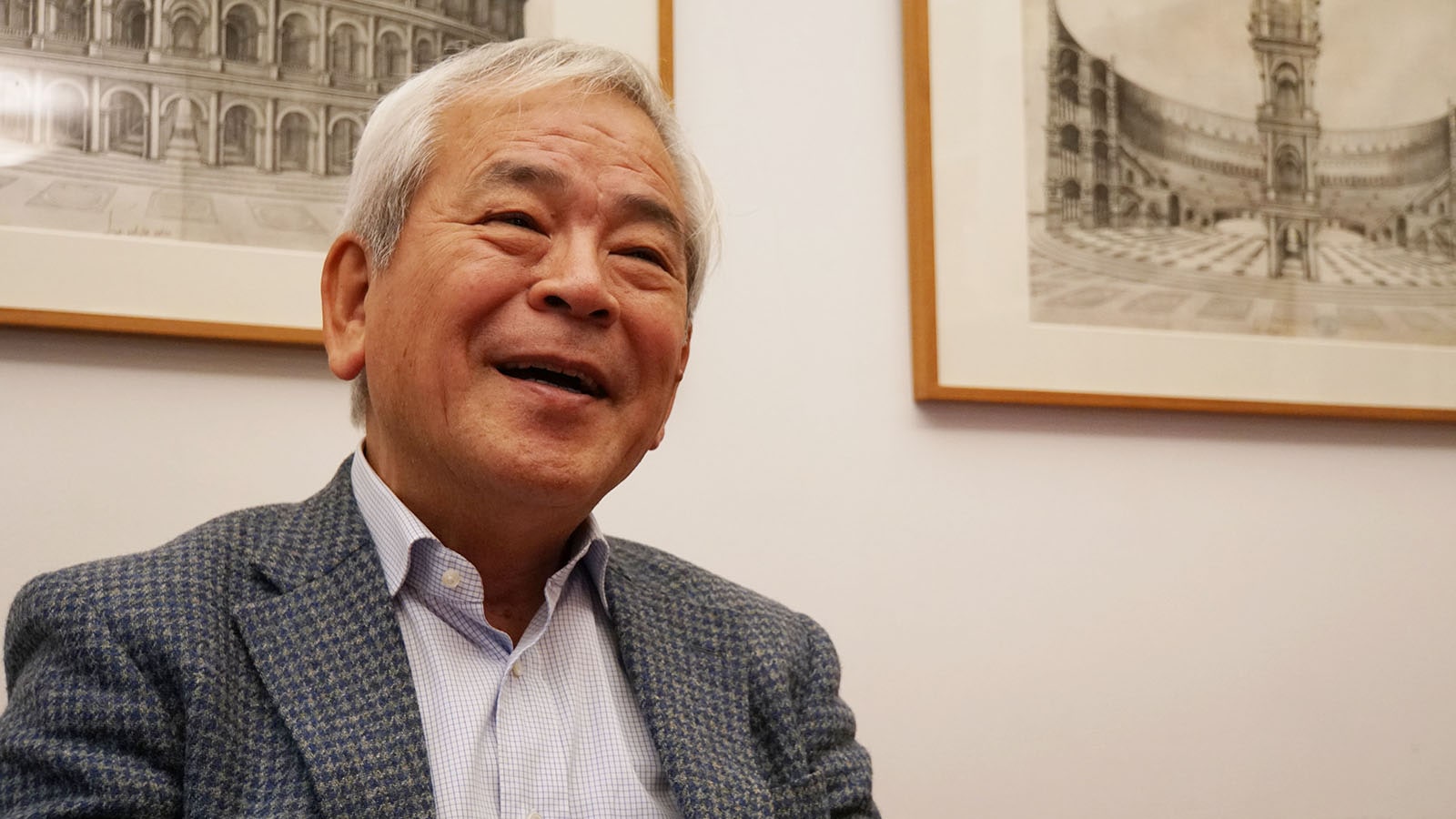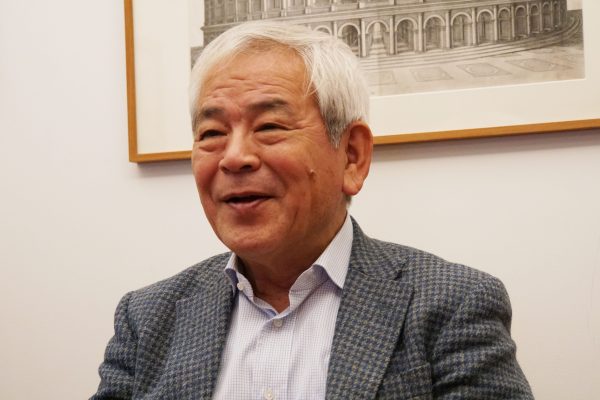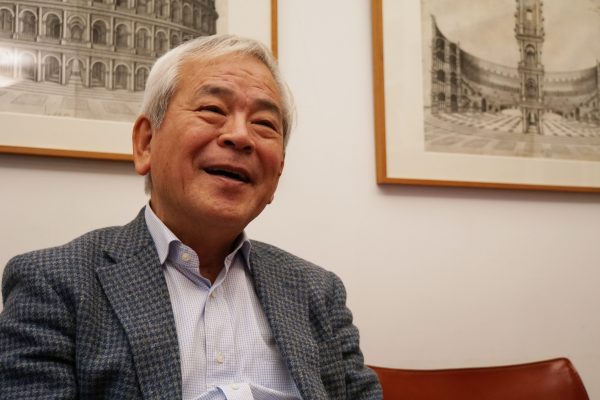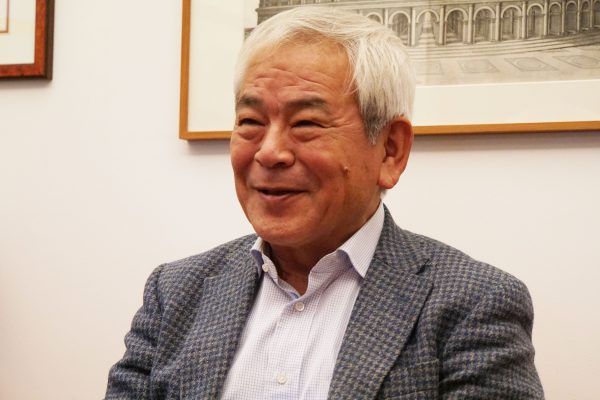
Column文化遺産コラム
Interview with the New Chair of JCIC-Heritage
27.03.2019

Interviewee Masanori Aoyagi
Third chair of the Japan Consortium for International Cooperation in Cultural Heritage, Professor Emeritus of the University of Tokyo
Born in 1944 in Dailian (China). As a prominent figure in research into ancient Greek and Roman art history, Mr. Aoyagi has carried out excavation surveys of Mediterranean ruins for more than 40 years. After graduating from the University of Tokyo’s Literature Department Faculty of Art History in 1967, he attended the University of Rome between 1969 and 1972 where he studied ancient Roman art history and archeology. He is a doctor of literature, and his experience includes being the chair of the Tokyo University Literature Department, vice president and director general of the National Museum of Western Art, chairman of the National Museum of Art, and Commissioner for Cultural Affairs.
He is currently a professor emeritus at the University of Tokyo and serves as director of the Yamanashi Prefectural Museum of Art and specially appointed professor at Tokyo University of the Arts. He is also a member of the Japan Academy. In 2011 he was awarded the NHK Broadcast Cultural Award, and in 2017 he was awarded the Order of the Sacred Treasure, Gold and Silver Stars.
Tell us about your aspirations
The importance of the JCIC-Heritage is increasing greatly. During the economic bubble era, Japan provided great amounts of official development assistance (ODA), but it subsequently shrank rapidly and the amount as a proportion of gross national income (GNI) has also fallen. In contrast, there are other countries that are working hard to maintain the amount of aid they provide and increase their presence by providing proactive assistance. In Japan’s case, the amount of assistance the country provides is actually decreasing, so we have to turn our thoughts in another direction, and when we do so we will find that cultural assistance is important.
For example, we get requests from other countries asking us to work with them in preserving their cultural heritage, or in taking a step forward from there and utilizing their cultural heritage in ways that will attract visitors. This is just one example, but cultural cooperation, cultural exchange, and cultural assistance are extremely important in terms of Japan maintaining its status in the international community. The main thrust of this is developing and dispatching human resources, so I feel that this will also suit Japan in terms of government policy going forward.
This is why I believe the role of the JCIC-Heritage will become extremely important. As the word “consortium” suggests, it is important to share information and collaborate with domestic researchers, universities and research institutes, public agencies, international cooperation agencies and private organizations that provide assistance. It is also important to work together and learn where there are needs and where it is possible to undertake activities effectively, and seek out where the potential lies.
Another thing we have to do, I believe, is to get database and archive specialists involved in order to strengthen the sharing of information, as this will lead to enhancement of the activities of the Consortium itself.
The Agency for Cultural Affairs is taking another look at a bilateral agreement that was already in place with Italy, and is attempting to increase the extent of interaction. In re-examining what the substance of cooperation activities should be going forward, it has been proposed that we should look at ways of rescuing cultural heritage after a natural disaster. We have experience in the Great Hanshin Awaji Earthquake, the Great East Japan Earthquake, and the Kumamoto earthquakes, so if we decide to go in this direction I think we should accumulate information and use it for the benefit of the bilateral agreement.
Since 2014, the Nara National Research Institute for Cultural Properties has been working on an archeological project to gather information regarding damage from past earthquakes and volcanic eruptions using archeological samples and historical documents for publication in a database that it intends to build. To this end, it has been undertaking activities including the gathering of data related to damage that natural disasters have caused to cultural heritage. Of course, we want to be proactively involved in this so that we can enjoy the assistance of the Nara National Research Institute for Cultural Properties.
And then there are the things that come directly to me. Libya is still far from stability in terms of security, and Algeria continues to face a severe situation. The only country in the area moving towards stability is Tunisia, and I hear there are people who wish to undertake activities such as creating archaeological maps. The request made to Japan for cooperation is not for excavation itself, but for the type of survey that forms the basis of such activities.
So as I have mentioned here, you can see that much is expected of the Consortium. As I said at the start, if we share information with stakeholders, proceed with discussions on a range of issues and indicate a definite direction, and take this forward at the current level, we will be able to meet a certain level of social expectation. On the other hand, this may also lead to increased cooperation with the Consortium from outside.
Your thoughts on international cooperation
There are many different ways of doing things in international cooperation. I think that something like Médecins Sans Frontières would be the best form of international cooperation to grow internationally and make the largest contribution. At the same time, I think that there are many places giving consideration to how to protect the cultural heritage a country has, or how to gather damaged cultural artifacts and repair and restore them. I hope that Japan gets more proactively involved in these areas, but Japan has the lowest number of public officials per citizen in the world. Italy, for example, currently has around 70 involved in the restoration of the archeological museum in Naples. So if they received a request to help with the preservation of ruins in the form of international cooperation, they could dispatch five or ten people. However, in the case of Japan, there have always been very few specialists in preservation and restoration in public bodies, including at independent administrative institutions, so it is very difficult to dispatch people. Ultimately the solution ends up being cash-based, meaning Japan’s presence on the ground is very weak. I think we should reconsider this in a more strategic way, and if we had some kind of international cultural heritage rescue squad that could go to any country in the world when the call came, it could boost Japan’s presence and lead to a more just appraisal of Japan’s contribution. While we do use our budget, we do not really go beyond this, so Japan’s contribution is underestimated within international society in this respect.
On the other hand, the work on cultural heritage that Japanese people are actually involved in overseas is highly precise and they are doing an excellent job, so the specialists in these countries are full of praise for them. There are many situations in which I hear from people that they want Japan to be involved, so I feel that thinking hard and coming up with a way to bring this kind of situation into the light is one of the roles of the Consortium.
Tell us on projects currently you are specifically engaged in
Since 2002, there has been a project under way in a place called Somma Vesuviana near Naples to excavate ruins from the Roman era. Thankfully, it has been included as a general academic project in the budget of the University of Tokyo, and it is currently ongoing with around 50 million yen of funding just in terms of the money used on the ground each year. There is currently no site that is undergoing a more organized and academic survey in Italy than this one. Around four years ago, Italian firefighters* came on a visit to the area with a focus on our site. Radiotelevisione Italiana (RAI) – the Italian state broadcaster, similar to NHK – made the effort to come and film the cultural heritage rescue training and the state of the rescue, such is the status of this site. It was suspected that these were the ruins of Augustus’s villa, but the results of the excavation were more or less unable to prove this. The surrounding community had great expectations for the project, and they changed the name of the nearest station to the site from Mercato Vecchio (the name of an old market) to Villa Augustea (Augustus’s villa). In this way, the project is contributing to bringing vibrancy to the region, and the people from the region believe that this site is the only thing that can do so. There are many citizens’ archeology clubs and other such clubs, and I want to come up with ideas to get them as deeply involved as possible so that they take on responsibility for the ruins going forward. Thankfully, University of Tokyo associate professor Akira Matsuda – who studied public archeology in the UK – is working on this project as one of his own pilot projects. Following his opinions and advice, the citizens are gaining an increasing awareness that the ruins belong to their community, while we are undertaking scientific surveys.
In addition, there is an international union of academics called Union Académique Internationale (UAI). It has a range of sub-organizations, and there is a committee that is trying to create a map of ruins from the Roman Empire. I am involved in this. Europe has many such venues for exchanging information and there are many different committees that form the core of such international networks, so I hope that young researchers participate in them as early as they can, and that they work to internationalize Japan’s human sciences. In the same way, I hope that the Consortium, which accumulates a wide range of information on internationalization, can contribute to the internationalization of the humanities in Japan.
*The first people to respond to emergencies in any place, including cultural heritage sites.




